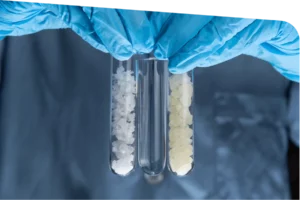
Polymer Chemistry Innovations made from the same elements, but with different properties. For instance, linear polymers are not rigid lines. They can also contain single bonds that swivel around, like paper clips. Some examples of linear polymers are: Butadiene, formaldehyde, and milk. In 1907, Belgian-American chemist Leo Baekeland discovered the hard, black substance Bakelite, which proved to be a great insulator. It was later used in household appliances and telephones. Eventually, chemists added pigments to this substance to make colored plastics.
Medical Devices, Blood Bags, Syringes, Surgical Sutures,& Contact Lenses.
Polymer Chemistry Innovations has a variety of applications. It can found in medical devices, such as blood bags, syringes, surgical sutures, and contact lenses. It is used in everyday life, from toothbrushes to toothpaste. Personal hygiene and security applications include lubricants and detergents, bulletproof vests, and space suits. Further, it is used in money, where polymer banknotes are used as currency.
Polymers commonly used in everyday life. They used in sports and work environments. In the home, polymers can found in clothing, textiles, and cosmetics. The field of Polymer Chemistry Innovations is becoming more interdisciplinary and diverse, with scientists finding new ways to synthesize molecules and mimic nature. It has no longer considered dirty by most universities. Today, every department has someone doing the polymer stuff.
Pportunities for Applications & Inventions.
The field of Polymer Chemistry Innovations has expanded to include more applications than ever before. From paint to sunglass lenses, polymers are widely used in electronics and everyday life. They are used in a variety of industries, including food and medicine. Using these polymers has used for centuries, and further research has needed to create more efficient and useful products. Once the science is advancing, there are many new opportunities for applications and inventions.
In the past century, people have used polymers. The first scientist to discover polymers was Hermann Studadinger, who won the Nobel Prize in chemistry for discovering the chemical structure of natural rubber. Since then, the field has continued to grow and expand. As the use of polymers grows, researchers are developing new materials that mimic the properties of nature. In addition to building products that mimic the properties of natural materials, researchers are exploring polymers’ properties and behaviors.
Possibilities of Synthetic Polymers,
There are many examples of how Polymer Chemistry Innovations used in our daily lives. Among the most common examples is the use of PVC in pipes. The use of polymers is vast and the world is in constant need of these materials. There are hundreds of other applications in our everyday life. Its potential is endless, and there is even an app for it in your pocket. When you see the many possibilities of synthetic polymers, you can understand why they used in the first place.
The average person is in contact with hundreds of different polymers. In fact, she may encounter as many as seven hundred different types of materials in her daily routine. She might have a plastic toothbrush, a molded plastic shower, or a polystyrene-plastic container. The most common of these compounds is PVC. The most familiar is the tetrafluoroethylene-polymer, while tetrafluoroethylene-based compound is a thermoplastic.
Probably Familiar with Artificial Polymers,
Although you’re probably familiar with artificial polymers, these compounds are also widespread. For instance, you might familiar with the various types of plastics used in your everyday life. For example, PVC is a plastic that has made of ethylene. Its properties are similar to those of the material. It’s often a mixture of two different substances. These synthetic materials made by mixing one kind of monomer.
The field of Polymer Chemistry Innovations has advanced in every area. From developing new polymers to creating artificial ones, the field has made tremendous progress. These advancements include better theoretical models and more effective methods of synthetics. In addition, the field is becoming more interdisciplinary. The fields of physics, chemistry, and engineering are increasingly focusing on the study of the properties of these compounds. It has a significant impact on the way we live and communicate.


